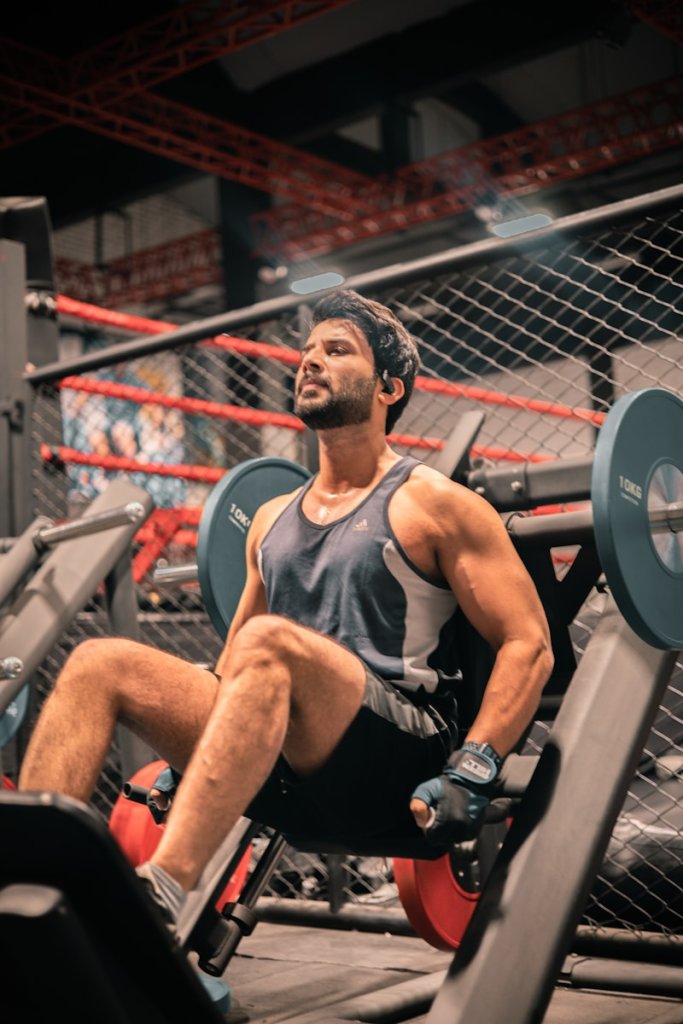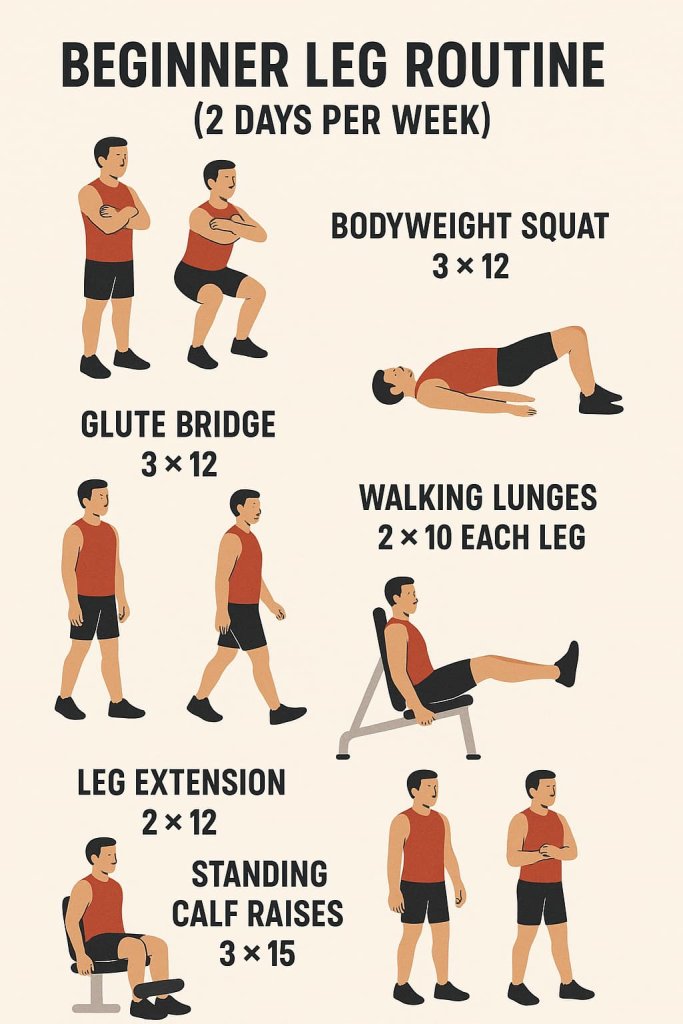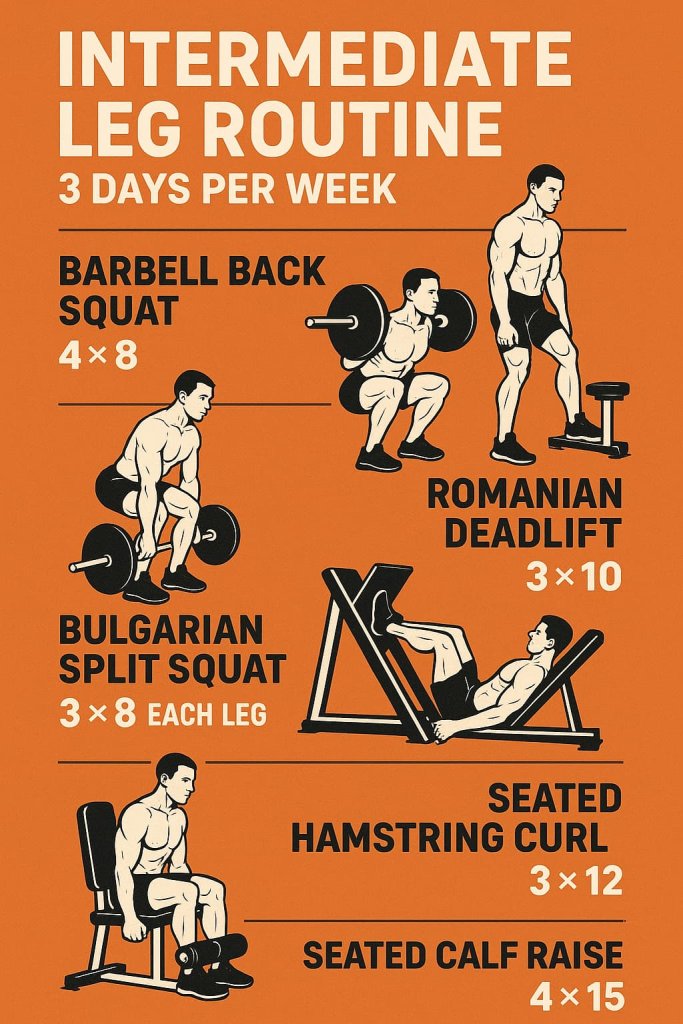The most effective leg workout routine includes squats, deadlifts, lunges, hip thrusts, and accessory moves like calf raises. These compound and isolation exercises together ensure balanced development of the quads, hamstrings, glutes, and calves. Training your legs regularly is essential not only for muscle growth but also for improving balance, stability, athletic performance, and preventing injuries.

This guide breaks down why leg workouts are important, which exercises matter most, and how to build structured routines for beginners, intermediates, and advanced lifters. You’ll also find expert tips, science-backed programming, and a helpful FAQ section.
Why Leg Workouts Are Non-Negotiable
Leg day isn’t just about looks—it’s the foundation of strength training. According to Verywell Health (2025), squats improve strength, flexibility, posture, and calorie burn. Strong legs support daily tasks like walking, climbing stairs, or carrying loads, while also fueling performance in sports and heavy lifts.
Benefits of regular leg workouts include:
- Increased overall strength and power
- Better posture and injury prevention
- Faster metabolism and fat loss support
- Improved balance, coordination, and flexibility
- Enhanced sports and functional performance
Skipping leg workouts can lead to muscle imbalances that affect your spine, knees, and hips—making consistent lower-body training a must.
Muscles Targeted in a Leg Workout
A proper routine should target all the key muscles:
- Quadriceps (front thigh): Responsible for knee extension and core stability during squats and leg presses.
- Hamstrings (back thigh): Support hip extension and knee flexion, activated in deadlifts and curls.
- Glutes: Your body’s powerhouse for hip drive, sprinting, and stability.
- Calves (gastrocnemius & soleus): Key for ankle strength, balance, and explosive power.
- Hip stabilizers (adductors & abductors): Keep movements aligned and prevent knee collapse during single-leg work.
Balanced training ensures no muscle is left behind, helping both aesthetics and performance.
Best Leg Exercises to Include
Based on expert consensus from Barbell Medicine (2025) and Healthline (2025), the most effective exercises are:
Compound Exercises (Strength & Mass Builders)
- Back Squat / Front Squat – King of leg training, hitting quads, glutes, and core.
- Deadlifts (Conventional, Romanian, Sumo) – Posterior chain builder targeting hamstrings and glutes.
- Lunges & Bulgarian Split Squats – Improve unilateral strength and stability.
- Hip Thrusts / Glute Bridges – Best for glute activation and explosive power.
- Leg Press – Allows heavy loading with reduced spinal stress.
Isolation & Accessory Exercises
- Leg Extensions – Focused quad development.
- Hamstring Curls (seated or lying) – Essential for knee joint health.
- Calf Raises (standing & seated) – Build ankle power and lower-leg aesthetics.
- Step-Ups / Box Jumps – Great for athletic explosiveness.
Sample Leg Workout Routines
Beginner Leg Routine (2 Days per Week)

Ideal for those starting out. Focus on form and controlled movement.
- Bodyweight Squat – 3 × 12
- Glute Bridge – 3 × 12
- Walking Lunges – 2 × 10 each leg
- Leg Extension – 2 × 12
- Standing Calf Raises – 3 × 15
Tip: Master these before adding weights.
Intermediate Leg Routine (3 Days per Week)

Perfect once you’ve built some strength base.
- Barbell Back Squat – 4 × 8
- Romanian Deadlift – 3 × 10
- Bulgarian Split Squat – 3 × 8 each leg
- Leg Press – 3 × 12
- Seated Hamstring Curl – 3 × 12
- Seated Calf Raise – 4 × 15
Tip: Add progressive overload weekly by increasing weight or reps.
Advanced Leg Routine (4–5 Days per Week)
For strength and hypertrophy. Focus on heavy compound lifts.
- Front Squat – 5 × 5
- Conventional Deadlift – 4 × 5
- Bulgarian Split Squat – 4 × 8 each leg
- Hip Thrust – 4 × 10
- Hack Squat or Leg Press – 4 × 10–12
- Hamstring Curl – 3 × 12
- Heavy Calf Raises – 5 × 12
Tip: Do compounds early in the workout, accessories later.
Programming Strategy & Science Insight
Recent research highlighted by Menno Henselmans (2025) suggests that the sequence of leg exercises impacts performance. A fatigue-optimized order is:
- Hamstring Curl
- Romanian Deadlift
- Leg Extension
- Squat
This structure balances fatigue across muscle groups, potentially leading to greater strength and size gains.
General Guidelines:
- Hypertrophy: 8–15 reps, 60–90 sec rest
- Strength: 4–6 reps, 2–3 min rest
- Train legs 2–3 times weekly for best results
Tips for a Safer & More Effective Leg Day
- Warm up with 5–10 minutes of dynamic stretches and mobility work
- Use progressive overload (increase weights gradually)
- Include unilateral moves to correct imbalances
- Prioritize form to protect knees and lower back
- Track your lifts and adjust weekly
- Combine compound and isolation moves for full development
Functional Fitness Benefits
A 2025 review of 145 studies (Woman & Home) found that functional lower-body exercises—like lunges, deadlifts, and box jumps—improve real-world performance, agility, and injury resilience. Training your legs goes beyond aesthetics; it enhances daily life and sports performance.
Read Also: Fast Recovery After Leg Day
Frequently Asked Questions (FAQ)
1. How many times a week should I train legs?
Most people see best results with 2–3 sessions per week.
2. Can I train legs and upper body on the same day?
Yes, in a full-body split, but prioritize energy for big lifts.
3. Squats vs Deadlifts: which is better?
Both are essential. Squats target quads and glutes; deadlifts target hamstrings and posterior chain.
4. How long should a leg workout take?
45–75 minutes, depending on volume and rest.
5. Do I need gym machines?
No. Free weights and bodyweight moves are enough, but machines can add safety and variety.
6. How can I avoid knee pain?
Strengthen hamstrings and glutes, warm up properly, and focus on form.
7. Can leg workouts help with fat loss?
Yes. Big compound moves burn lots of calories and raise metabolism.
Conclusion
Leg training is the foundation of strength, balance, and athleticism. By combining squats, deadlifts, lunges, hip thrusts, and accessory work, you’ll build power and resilience that carry over to every aspect of life.
Start simple, focus on form, and gradually progress to more advanced routines. Over time, strong legs will enhance your physique, prevent injuries, and maximize performance.
Ready to transform your fitness? Choose the plan that matches your level and start your next leg day with confidence.
